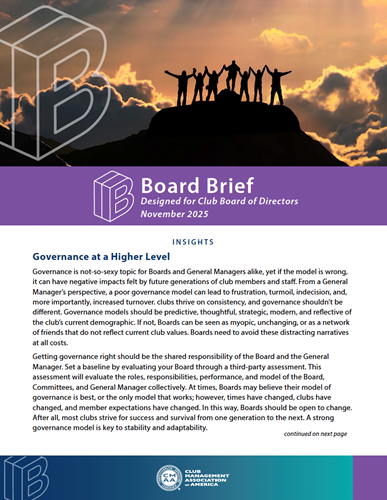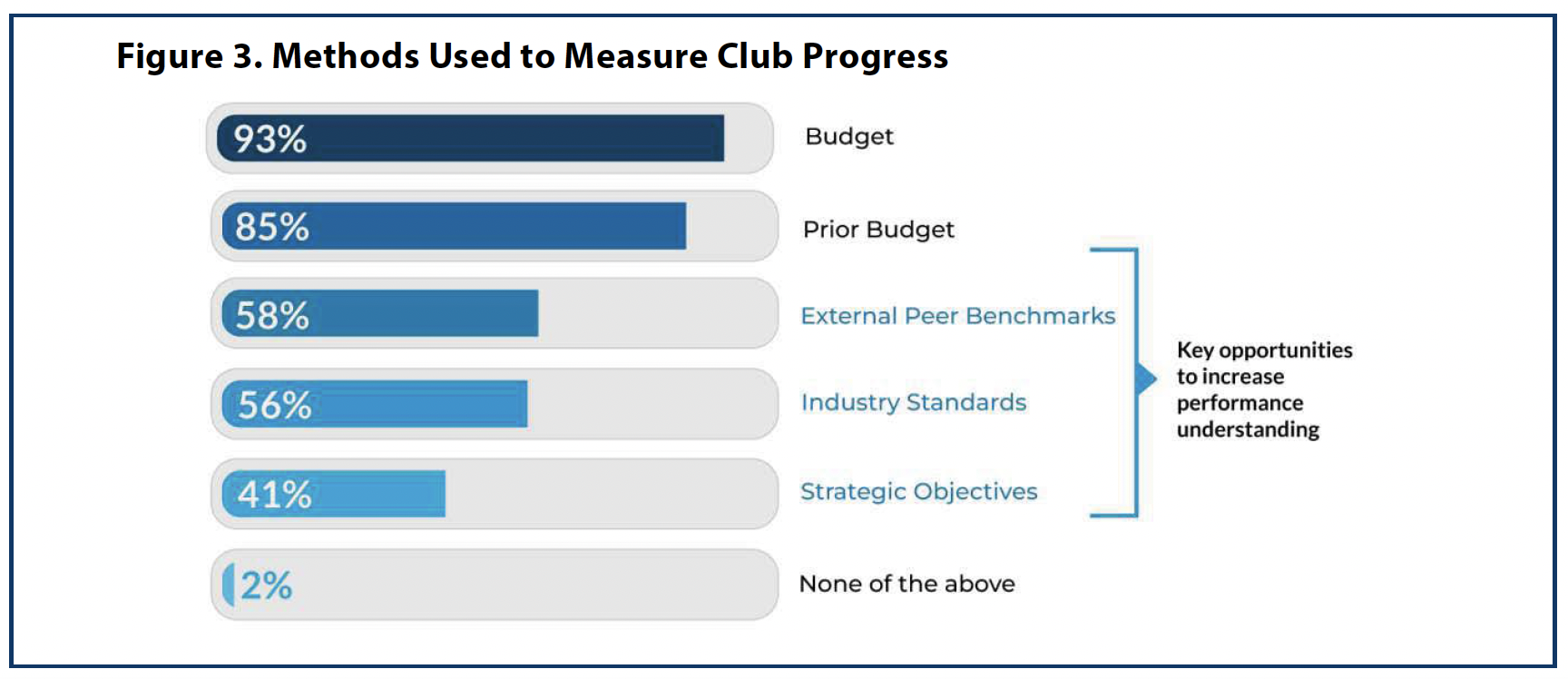Board Brief
November 2025
Designed for Club Board of Directors

Inside this Issue:
-
Insights: Governance at a Higher Level
Governance is a not-so-sexy topic for Boards and General Managers alike, yet if the model is wrong, it can have negative impacts felt by future generations of club members and staff. -
By the Numbers: Maximizing Club Value
Club leaders and their teams create value for their members but often face challenges in measuring and effectively communicating it. Clubs can help members recognize the benefits they receive by prioritizing effective communication and aligning outcomes to strategic priorities. -
Communicating Capital Projects—The Three C’s Every Club Needs
Capital projects are some of the most exciting moments in a club’s history. They signal growth, reinvestment, and a commitment to the member experience. But they can also be the most stressful. -
External Influences: Podcast Spotlight: The Evolution of Golf and Golf Cars
When you think about golf cars and personal transport vehicles, your first thought probably centers on transportation. But there is a lot more to consider. -
CMAA News & Announcements: The 2026 CMAA World Conference & Club Business Expo: A Growth Opportunity for Your Club Management Professionals
Club management professionals from around the world will gather February 17-21, 2026, in Anaheim, CA, at the CMAA World Conference & Club Business Expo.

Insights
Governance at a Higher Level
Governance is a not-so-sexy topic for Boards and General Managers alike, yet if the model is wrong, it can have negative impacts felt by future generations of club members and staff. From a General Manager’s perspective, a poor governance model can lead to frustration, turmoil, indecision, and, more importantly, increased turnover. Clubs thrive on consistency, and governance shouldn’t be different. Governance models should be predictive, thoughtful, strategic, modern, and reflective of the club’s current demographic. If not, Boards can be seen as myopic, unchanging, or as a network of friends that do not reflect current club values. Boards need to avoid these distracting narratives at all costs.
Getting governance right should be the shared responsibility of the Board and the General Manager. Set a baseline by evaluating your Board through a third-party assessment. This assessment will evaluate the roles, responsibilities, performance, and model of the Board, Committees, and General Manager collectively. At times, Boards may believe their model of governance is best, or the only model that works; however, times have changed, clubs have changed, and member expectations have changed. In this way, Boards should be open to change. After all, most clubs strive for success and survival from one generation to the next. A strong governance model is key to stability and adaptability.
Annually, Boards should review term limits, committee charters, evaluate individual Board and committee member contributions, and, most importantly, assess how they are cultivating members for eventual Board service. High-level, strategic governance should be the priority in private clubs.
Of equal importance is the Board’s focus. Is the Board worried about the hamburger in the dining room, or the amount of capital it will allocate in the coming year for obligatory and aspirational capital? The answer should be easy! No club will be perfect at the transactional level, but those conversations should not take place in the Board Room during a meeting. As a Board, you’ve selected a competent General Manager; let them manage without operational impediments unless necessary. Even then, the conversation shouldn’t detract from strategic discussions in the boardroom.
For example, once the Board approves the operational and capital budgets for the year, there should be minimal additional discussion. Instead, the Board should receive monthly KPI’s from the General Manager and CFO with a written report before the meeting that says why things are good, or where the concerns are, and what is being done to address them. This allows for targeted questions to be asked, allowing the Board to refocus quickly on strategy.
Annual Board evaluations and their resulting recommendations can be a significant tool for Boards to demonstrate the club’s commitment to generational stability and success.
In short, governance is not a back‑office nuisance—it is the backbone of a Club’s future. Boards and General Managers must partner to evaluate, modernize, and hold governance accountable through regular third‑party assessments, clear role delineation, term limits, and intentional succession planning. Keep Board conversations strategic, rely on the General Manager to manage operations, and use KPI reports to inform targeted questions rather than operational debate. By committing to this disciplined, forward‑looking approach, clubs will build the stability and adaptability necessary to serve members and staff well for generations.
Insights by M. Kent Johnson, CCM, CCE, ECM

By the Numbers
Maximizing Club Value
Club leaders and their teams create value for their members but often face challenges in measuring and effectively communicating it. Clubs can help members recognize the benefits they receive by prioritizing effective communication and aligning outcomes to strategic priorities.
The 2025 edition of the Club Leaders’ Perspective Report from CMAA and GGA Partners dives into these insights. The following is excerpted from the report:
Key Insights
- Club leaders are more confident in creating member value than in measuring and communicating it, missing key opportunities to share their impact across stakeholder groups
- A key opportunity to improve value-based insights is to measure club progress against strategic priorities and objectives.
- Clubs can improve their value perception by prioritizing member communication, aligning KPIs to strategic priorities, and establishing a structured reporting plan.
Improving Value Perceptions
Club leaders face an important challenge: although 66 percent are confident in creating value for their members, only 35 percent feel effective at communicating that value. This notable communication gap can result in missed opportunities for engagement and member satisfaction. But how can leaders address this issue?
Providing Member Value
Private clubs often allocate significant resources—time, money, and attention—to creating member value; however, extending this effort to include a deliberate plan for measuring and communicating that value is often missed. Results presented in Figure 1 indicate that while two-thirds believe their club provides the value members expect, only 48 percent and 45 percent believe they do a good job of measuring and communicating that value to members, respectively.
But why emphasize the delivery and measurement of member value? When neglected, clubs miss an opportunity to showcase how high-profile capital projects and operational tactics can generate value and support the execution of strategic priorities. They also contribute to the club’s success by establishing clear metrics for communicating successes and challenges. Ultimately, providing value-focused information to members helps ensure transparency regarding efforts to enhance member understanding and engagement.
Lack of Member Understanding
Club leaders face the challenge of delivering quality experiences while also ensuring members understand the value they are receiving. Respondents were asked to rank 23 attributes regarding members not understanding the value they receive, to know where leaders find challenges. Figure 2 shows that leaders perceive the leading disconnect is in areas fundamental for providing experiences and not actual experiences. These areas include ongoing facility maintenance and upkeep, increased employee compensation, and the growing number of employees necessary to maintain service levels. Concerns also exist in key experiential elements of many clubs—dining and golf—suggesting that members’ views do not necessarily consider the efforts and resources needed to provide these experiences.
Aligning Strategy with Measurement
Delivering, measuring, and communicating value is inherently tied to a club’s overall strategy. Therefore, decisions regarding desired service levels, amenities, and facility conditions should closely align with the club’s strategic priorities and objectives. However, as shown in Figure 3, there is room for improvement in the methods used for monitoring success. Results show that while most clubs compare their results to budget (93 percent) and prior periods (85 percent), far fewer consider other points of comparison that may add meaningful context to performance such as industry standards (56 percent), external peer benchmarks (58 percent), and strategic objectives (41 percent).
CMAA members may access their complimentary copy of the full report through CMAA Connect in the Best Practices Exchange Community Library in the CMAA Annual Reports folder.

Best Practices
Communicating Capital Projects—The Three C’s Every Club Needs
Capital projects are some of the most exciting moments in a club’s history. They signal growth, reinvestment, and a commitment to the member experience. But they can also be the most stressful. A multi-million-dollar investment, months of disruption, and the reality of increased dues or assessments naturally create pressure for members. And when there is pressure, there is gossip.
If you don’t control the narrative, your members will. In the absence of information, people curate their own stories, often the worst-case scenario. Rumors spread faster than fact sheets, and before long, skepticism overshadows excitement.
Strong communication changes that story. Done well, it keeps members informed, confident, and engaged. It eliminates guesswork, reduces gossip, and ensures the right story is the one being told. The most effective strategies are built around the Three C’s: Connection, Confidence, and Community.
Connection
Every communication should connect the project back to the member experience. It is not enough to share the what, you need to share the why. Just like all marketing and communication efforts, starting with the why builds understanding, trust, and buy-in. It shifts the conversation from “Why are we spending this money?” to “I see how this investment will directly improve my experience at the club.”
Strategies to Build Connection:
- Translate features into benefits: Don’t just say “new irrigation system,” explain how it means better playing conditions year-round.
- Use visuals: Renderings, fly-through videos, or simple side-by-side comparisons of “before and after” make it real.
- Personalize: Feature member testimonials (“As a parent, I can’t wait for the new family locker rooms…”) to show how projects improve daily life.
Confidence
Confidence comes from transparency. When communication feels vague or delayed, members fill the silence with rumors. When it feels steady and honest, members trust the process. Strong communication acknowledges both the excitement and the sacrifice that come with capital projects. Members want to know not just what is happening but also why decisions were made, how money is being spent, and what the timeline looks like. Even if every answer is not perfect, candor builds credibility.
Confidence also comes from consistency. A regular cadence of updates through emails, town halls, newsletters, or quick video messages reassures members that leadership is in control. Silence, on the other hand, breeds doubt.
The takeaway is simple: members can accept inconvenience and even setbacks if they trust the information they are receiving. They cannot accept uncertainty.
Strategies to Build Confidence:
- Create a project communication calendar: Share updates at set intervals (weekly, monthly) so members know when to expect news.
- Provide FAQs: Answer tough questions upfront so you control the narrative.
- Show progress: Short video updates from leadership/committees or construction walk-throughs show the project is on track.
Be candid: if something slips, acknowledge it early and explain how you’re addressing it.
Community
Capital projects should bring members together, not divide them. The best communication invites members into the journey. That means creating opportunities for members to feel included, informed, and engaged. Host Q&A sessions where leadership listens as much as it speaks. Offer hard-hat tours so members can see progress with their own eyes. Share behind-the-scenes photos and updates that make them feel part of the story.
Community also grows when milestones are celebrated. A topping-off ceremony, a ribbon cutting, or even a small gathering to mark the completion of a phase helps members take pride in the process. The more touchpoints you create, the more members feel like this is their project, not just the board’s. When members feel ownership of the journey, they become champions of the project rather than critics on the sidelines.
Strategies to Build Community:
- Create project ambassadors: Recruit a small group of respected members to serve as liaisons.
- Build interactive displays in the clubhouse: A progress board, renderings, or even a live-feed slideshow of construction photos can keep the project visible and tangible.
- Host mini pop-up events in unfinished spaces: A wine tasting in the framed-out dining room, or a casual meet-up on the new patio before it opens, can turn construction into an experience.
Capital projects are about people and culture, not just buildings. Clubs that lead with Connection, Confidence, and Community find that the vote passes more smoothly, the work progresses with less friction, and the membership emerges stronger, prouder, and more united than before.
Insights by Erica Martin, Director of Marketing & Member Experience, Strategic Club Solutions
External Influences
Podcast Spotlight: The Evolution of Golf and Golf Cars
When you think about golf cars and personal transport vehicles, your first thought probably centers on transportation. But there is a lot more to consider—golf cars can improve the member experience, expand accessibility, enhance your service opportunities, and provide vital support for maintenance and other daily operations.
In this episode of Let’s Talk Club Management, we’re joined by Brad Schaufert, one of our partners at E-Z-GO, to talk about this important club component. E-Z-GO is a globally renowned leader in the design and manufacture of golf cars and personal transport vehicles, known for its innovation in sustainable electric vehicles and powertrain technology.

CMAA News & Announcements
Club management professionals from around the world will gather February 17-21, 2026, in Anaheim, CA, at the CMAA World Conference & Club Business Expo. The industry’s largest annual gathering offers five days of energizing education, a two-day Club Business Expo, networking, and experiences—cultivated specifically for club management professionals. Will your club’s management team be attending?
Recruit next generation club talent.
CMAA’s on-site career resources offer clubs the opportunity to post club openings at no cost and engage directly with attendees seeking new positions. Further, attendees can participate in specifically designed networking sessions for professionals and student attendees. Clubs can highlight their internship and entry-level opportunities and meet directly with hospitality students from 40 hospitality programs around the country.
Gain new insights and ideas.
With more than 65 educational offerings across all areas of club operations, attendees can learn directly from industry experts and key practitioners like lifelong hospitalian Bobby Stuckey and customer experience expert Elizabeth Dixon. Attendees can also create their own think tanks with Open Space and tap into the wisdom of other clubs. Additionally, the Idea Fair spotlights hundreds of club-tested solutions for event programming, staff recruitment and retention, communications, and more.
Discover innovation and inspiration at the Club Business Expo.
The Club Business Expo, February 19-20, provides an opportunity to harvest vibrant ideas and fruitful connections. This two-day experience is bursting with possibilities featuring more than 260 companies highlighting cutting-edge products and services for your club. Find your club’s next big idea and fresh insights in the New Product Showcase and Apparel Mart!
Early registration discounts apply through December 11.





